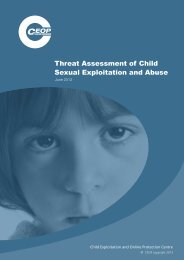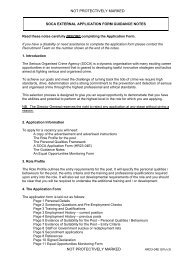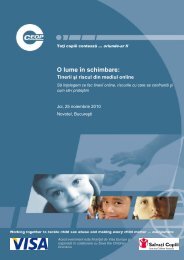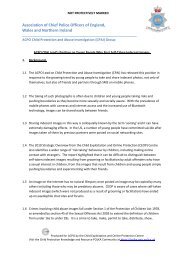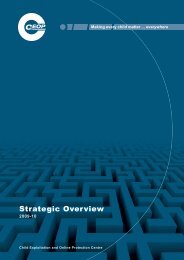The trafficking of women and children from Vietnam - CEOP
The trafficking of women and children from Vietnam - CEOP
The trafficking of women and children from Vietnam - CEOP
Create successful ePaper yourself
Turn your PDF publications into a flip-book with our unique Google optimized e-Paper software.
NOT PROTECTIVELY MARKED<br />
4. Trafficking trends in <strong>Vietnam</strong>, recruitment <strong>and</strong> debt bondage<br />
4.1 Trafficking statistics (<strong>women</strong> <strong>and</strong> girls)<br />
Between 2005 <strong>and</strong> 2009, approximately 6,000 <strong>trafficking</strong> victims were recognised as such.<br />
Of these, 3,190 were identified by Chinese <strong>and</strong> <strong>Vietnam</strong>ese authorities, resulting in 3,190<br />
court cases. 8 However, approximately 40,000 9 <strong>women</strong> <strong>and</strong> <strong>children</strong> are recorded as missing<br />
<strong>and</strong> are unaccounted for. <strong>The</strong> authorities are concerned that they may have been trafficked.<br />
Of the certified victims, 60% escaped <strong>from</strong> their <strong>trafficking</strong> situation themselves, with 25%<br />
being rescued by the police. <strong>The</strong> remaining 15% were repatriated or were returned as a<br />
result <strong>of</strong> a ransom paid by their families to the traffickers. 10<br />
60% <strong>of</strong> victims are trafficked to China, mostly <strong>from</strong> the central <strong>and</strong> northern provinces. 30%<br />
are trafficked to Cambodia with victims mainly originating in the south. <strong>The</strong> remaining 10%<br />
are trafficked to destinations across the world with Malaysia featuring prominently. Many<br />
victims may also be being trafficked, or re-trafficked, to Lao PDR, but figures are not<br />
available.<br />
In 2005 <strong>and</strong> 2006, a study was conducted by Save the Children which interviewed a number<br />
<strong>of</strong> trafficked returnees <strong>from</strong> 19 northern provinces in <strong>Vietnam</strong>. This study identified 78.9%<br />
to be Kinh <strong>Vietnam</strong>ese <strong>and</strong> the remaining 21.1% were composed <strong>of</strong> a number <strong>of</strong> minority<br />
ethnicities. 11 This differs <strong>from</strong> the national average where 13.8% <strong>of</strong> the population as a<br />
whole are ethnic minorities. <strong>The</strong> NGO Alliance Anti Traffic (AAT) confirms that large<br />
populations <strong>of</strong> ethnic minorities live in the provinces targeted by the traffickers.<br />
8 As stated earlier, to be recorded as a victim <strong>of</strong> <strong>trafficking</strong>, the victim has to be recognised as being trafficked<br />
by the authorities in the destination <strong>and</strong> the authorities in the source country. In addition, the trafficker has to<br />
be identified <strong>and</strong> prosecuted. <strong>The</strong>re are also concerns that the correct <strong>of</strong>fender is not always prosecuted or<br />
that those lower down the trafficker network hierarchy are prosecuted rather than the organisers.<br />
9 An accurate figure cannot be provided as there are no national records for missing people. Currently<br />
relatives report missing family to the police, who may then forward information to national bodies. It is<br />
unlikely that those who have left to find work abroad will be reported<br />
10 MOLISA<br />
11 Report on Assessing the Return <strong>and</strong> Reintegration <strong>of</strong> Victims <strong>of</strong> Cross-Border Trafficking. Save the Children,<br />
Hanoi, <strong>Vietnam</strong>. February 2008<br />
Page 10 <strong>of</strong> 31



